实验2 高效液相色谱法测定栀子药材中栀子苷的含量
高效液相法测定不同产地栀子中栀子甙的含量
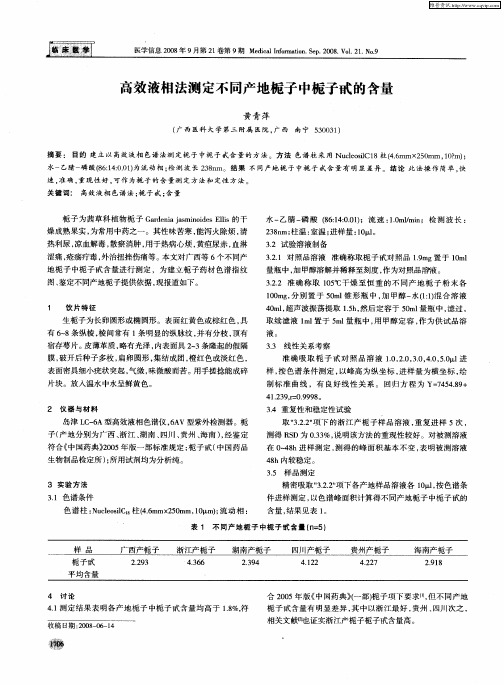
31 色谱条件 .
件进样测定 , 以色谱 峰面积计算得不 同产地栀子 中栀 子甙的
含 量 , 果 见 表 1 结 。
色谱柱 : u l sC8 (. mx 5 mm,O m)流 动相 N c oi l柱 4 m 2 0 e l 6 1 ;
35 样 品 测 定 .
岛津 L 一 A型高效液相色谱仪 ,A C6 6 V型紫外检测器。栀
子( 产地分别 为广西 、 浙江 、 湖南 、 四川 、 贵州 、 海南 )经鉴定 ,
符 合《 中国药典 )0 5年版一部标 准规定 ; )0 2 栀子甙( 中国药 品
生物制 品检定所 )所用试剂均为分析纯。 ;
水 一乙腈一 酸(61:.1为 流动 相 ; 测 波长 2 8m。 结 果 不 同产 地 栀 子 中栀 子 甙 含 量 有 明 显 差 异 。 结 论 此 法操 作 简 单 , 磷 8 : 00) 4 检 3n 快
速, 准确 , 重现 性 好 , 可作 为栀 子 的 含 量 测 定 方 法和 定 性 方 法 。 关 键 词 : 高效 液 相 色谱 法 ; 子 甙 ; 量 栀 含
1
饮 片 特 征
4r , O l超声波振荡 提取 1 h 然后定容于 5 r 量瓶 中 , a . , 5 Ol a 滤过 ,
生栀子为长卵圆形 或椭 圆形 。表 面红 黄色或棕红色 , 具 有 68 - 条纵棱 , 棱问常有 1 条明显的纵 脉纹 , 并有分枝 , 有 顶 宿存萼片。 薄革质 , 皮 略有光泽 , 内表面具 2 3 - 条隆起 的假隔 膜, 破开后种子多枚 , 扁卵 圆形 , 结成团 , 集 橙红色或淡红色 ,
321 对照品溶液 准确称取栀子甙对照 品 1 m . . . g置于 lml 9 O
高效液相色谱法测定栀子组分中栀子苷含量
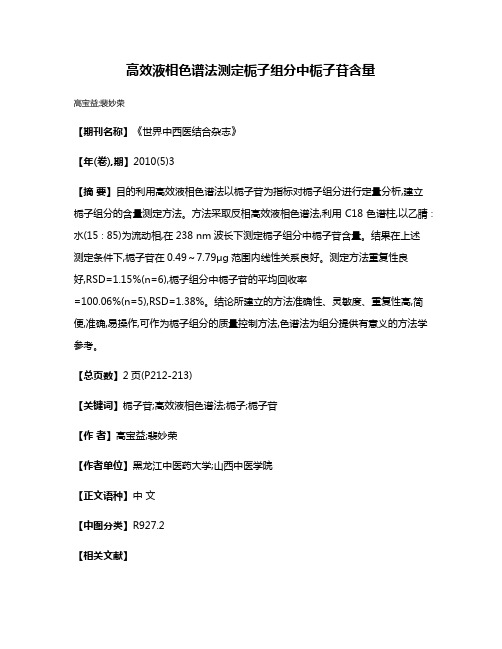
高效液相色谱法测定栀子组分中栀子苷含量
高宝益;裴妙荣
【期刊名称】《世界中西医结合杂志》
【年(卷),期】2010(5)3
【摘要】目的利用高效液相色谱法以栀子苷为指标对栀子组分进行定量分析,建立栀子组分的含量测定方法。
方法采取反相高效液相色谱法,利用C18色谱柱,以乙腈∶水(15∶85)为流动相,在238 nm波长下测定栀子组分中栀子苷含量。
结果在上述
测定条件下,栀子苷在0.49~7.79μg范围内线性关系良好。
测定方法重复性良
好,RSD=1.15%(n=6),栀子组分中栀子苷的平均回收率
=100.06%(n=5),RSD=1.38%。
结论所建立的方法准确性、灵敏度、重复性高,简便,准确,易操作,可作为栀子组分的质量控制方法,色谱法为组分提供有意义的方法学参考。
【总页数】2页(P212-213)
【关键词】栀子苷;高效液相色谱法;栀子;栀子苷
【作者】高宝益;裴妙荣
【作者单位】黑龙江中医药大学;山西中医学院
【正文语种】中文
【中图分类】R927.2
【相关文献】
1.反相高效液相色谱法测定不同品质栀子中栀子苷的含量 [J], 饶黄云;邹盛勤
2.高效液相色谱法测定栀子黄柏口服液中栀子苷的含量 [J], 李翔;刘皈阳;马建丽;周亮;黄欣欣
3.反相高效液相色谱法测定栀子金花丸中栀子苷的含量 [J], 郭永成;王学蕾
4.高效液相色谱法测定江津栀子中栀子苷含量 [J], 黄群莲;唐灿;张彦燕;李云鹏;赵剑
5.超高效液相色谱法测定生栀子和焦栀子药材中栀子苷含量 [J], 沈晨;吴虹;吴欢;滕越
因版权原因,仅展示原文概要,查看原文内容请购买。
高效液相法测定蒙药中栀子苷含量
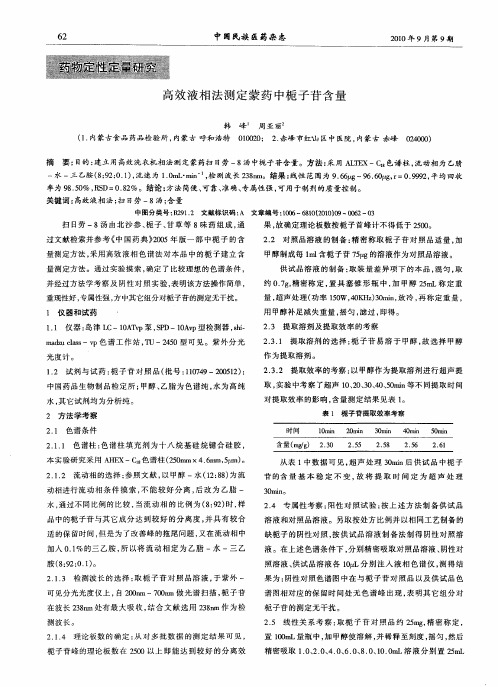
中 国民族 医药杂志
21 年9月第9 00 期
高 效 液相 法 测 定 蒙 药 中栀 子苷 含 量
韩 峰 周 亚 丽
(. 1 内蒙 古食 品 药品 检 验 所 , 内蒙 古 呼和 浩 特
ห้องสมุดไป่ตู้
002 ; 2 赤 峰 市红 区 中 医 院 , 100 . 内蒙 古 赤峰
O4 0 ) 2O 0
中国药品生物制 品检定所 ; 甲醇 、 乙脂为色谱纯 , 水为高 纯
水 , 它试剂均为分析纯。 其
2 方法学考察
2 1 色 谱 条 件 . 211 色谱柱 : 谱柱填 充剂 为十八 烷基硅 烷键合 硅胶 , .. 色
本 实 验研 究 采 用 A E H X—C8 1 色谱 柱 (5m 20 m× .m 5 n 。 4 6 m,/ ) a
24 专属性考察 : . 阳性 对 照 试 验 : 上 述 方 法 制 备 供 试 品 按
溶液和对照品溶液。另取按处方 比例并 以相同工艺制备 的
缺栀子的阴性对照 , 供试品溶 液制备 法制得 阴性对照溶 按
加入 0 1 .%的三 乙胺 , 以将流 动相定 为 乙脂 一水 一三 乙 所
胺 ( : : .) 89 0 1 。 2 2 13 检 测 波 长 的选 择 : 栀 子 苷 对 照 品 溶 液 , 紫 外 一 .. 取 于 可 见 分 光 光 度 仪 上 , 20m ~70m 做 光 谱 扫 描 , 子 苷 自 0n 0n 栀
2 32 提取效率 的考察 : .. 以甲醇作为提取溶剂进行 超声提
取 , 验 中考 察 了 超 声 1 、03 、0 5 rn 不 同提 取 时 间 实 O2 、04 、0 i等 a 对 提 取 效 率 的影 响 , 量 测 定 结 果 见 表 1 含 。
HPLC法测定栀子超微速溶饮片中栀子苷的含量
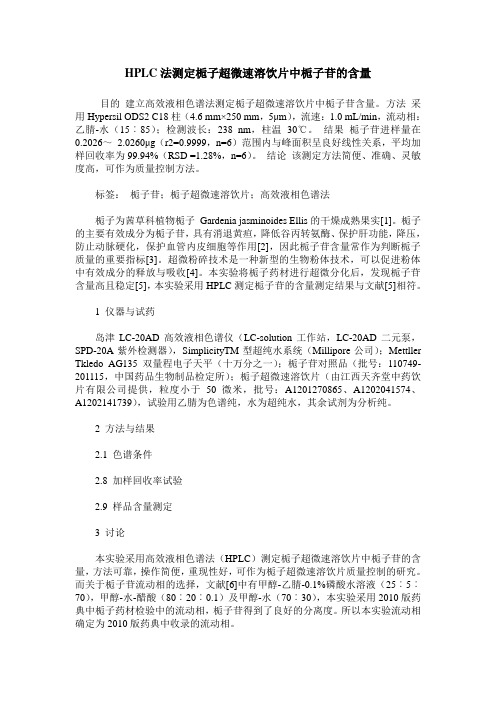
HPLC法测定栀子超微速溶饮片中栀子苷的含量目的建立高效液相色谱法测定栀子超微速溶饮片中栀子苷含量。
方法采用Hypersil ODS2 C18柱(4.6 mm×250 mm,5μm),流速:1.0 mL/min,流动相:乙腈-水(15︰85);检测波长:238 nm,柱温30℃。
结果栀子苷进样量在0.2026~2.0260μg(r2=0.9999,n=6)范围内与峰面积呈良好线性关系,平均加样回收率为99.94%(RSD =1.28%,n=6)。
结论该测定方法简便、准确、灵敏度高,可作为质量控制方法。
标签:栀子苷;栀子超微速溶饮片;高效液相色谱法栀子为茜草科植物栀子Gardenia jasminoides Ellis的干燥成熟果实[1]。
栀子的主要有效成分为栀子苷,具有消退黄疸,降低谷丙转氨酶、保护肝功能,降压,防止动脉硬化,保护血管内皮细胞等作用[2],因此栀子苷含量常作为判断栀子质量的重要指标[3]。
超微粉碎技术是一种新型的生物粉体技术,可以促进粉体中有效成分的释放与吸收[4]。
本实验将栀子药材进行超微分化后,发现栀子苷含量高且稳定[5],本实验采用HPLC测定栀子苷的含量测定结果与文献[5]相符。
1 仪器与试药岛津LC-20AD高效液相色谱仪(LC-solution工作站,LC-20AD二元泵,SPD-20A紫外检测器),SimplicityTM型超纯水系统(Millipore公司);Mettller Tkledo AG135双量程电子天平(十万分之一);栀子苷对照品(批号:110749- 201115,中国药品生物制品检定所);栀子超微速溶饮片(由江西天齐堂中药饮片有限公司提供,粒度小于50微米,批号:A1201270865、A1202041574、A1202141739),试验用乙腈为色谱纯,水为超纯水,其余试剂为分析纯。
2 方法与结果2.1 色谱条件2.8 加样回收率试验2.9 样品含量测定3 讨论本实验采用高效液相色谱法(HPLC)测定栀子超微速溶饮片中栀子苷的含量,方法可靠,操作简便,重现性好,可作为栀子超微速溶饮片质量控制的研究。
栀子药材中栀子苷的含量测定

1.2.7 样品的含量测定 精密称取干燥、粉碎的栀 子粉末适量,加甲醇 - 水(1 1 1)50 mI,超声振荡提取 30 min,过滤,滤液定容到 100 mI,精密稀释至与对照 品溶液相 近 浓 度,按“ 1 . 2 . 1”项 方 法 测 定 栀 子 苷 含 量,结果见表 1。
Table 1 The contents of sample(s ! = 3)
栀子药材不同部位栀子苷的含量不同[2],故选 择药材不同药用部位可能有含量的差异。
参考文献
1 中华人民共和国国家药典委员会,中国药典[S]. 一部 . 北京: 化学工业出版社,2000 . 201
2 唐盈 . 栀子及其炮制品京尼平苷的 含 量 测定[J]. 中 药通 报, 1988,1(3 6):18
Fructus Gardeniae .
Key ords:Fructus Gardeniae;Geniposide;RP - HPLC
CLC number:R917
Document code:A
Article ID:1006 - 010(3 2003)05 - 0374 - 02
栀子来源于茜草科植物栀子属的栀子( Gardenia jasminoides Ellis)及其同属多种植物的果实,为常用 中药材,具有泻火除烦、清热利尿、凉血解毒的功效, 其主要有效成分为多种环烯醚萜苷类化合物。中国 药典规定[1]:按干燥品计算,含栀子苷(geniposide)不 少于 1.8% 。由于药材栀子来源于多种植物,其品种 的产地不同,质量优劣差异很大,现选择不同品种和产 地的 12 批栀子,用反相高效液相色谱法测定栀子苷含 量,为栀子的优选提供科学依据。
制方法。
关键词:栀子;栀子苷;RP - HPLC
高效液相色谱法测定栀子苷含量的不确定度评定
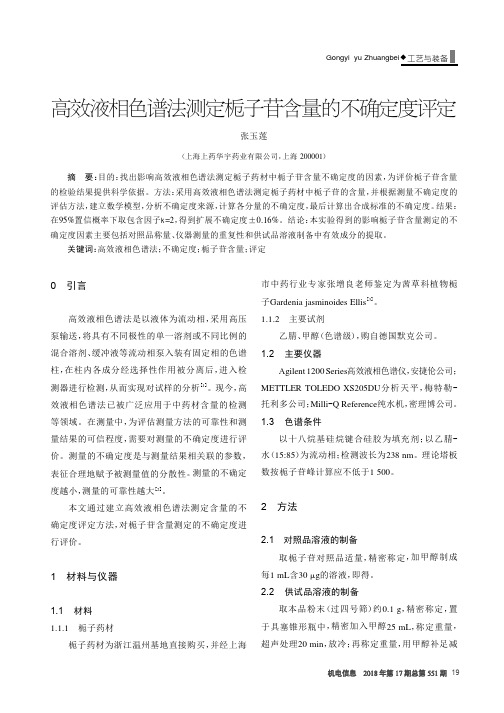
等领域。在测量中,为评估测量方法的可靠性和测 1.3 色谱条件
量结果的可信程度,需要对测量的不确定度进行评
以 十 八 烷 基 硅 烷 键 合 硅 胶 为 果相关联的参数, 水(15:85)为流动相;检测波长为238 nm。理论塔板
表征合理地赋予被测量值的分散性。测量的不确定 数按栀子苷峰计算应不低于1 500。
定度u3=0.010 68 mg。 (4)由于去皮称量,必须计算两次:
1 mL 移 液 枪 校 准 引 入 的 不 确 定 度 u1(V 1)=
0.001 =0.000 6 mL。 姨3
(2)由温度效应引入的不确定度:
法测定栀子苷含量引入的不确定度因素主要有以
合成不确定度ure(l M)= 姨urel(2 1)+urel(2 2)+urel(2 3) 式中 ur(el 1)———对照品溶液浓度引入的不确定度;
ure(l 2)— ——供试品溶液浓度引入的不确定度; ure(l 3)— ——重复性测量制备引入的不确定度。 3.3 分量的计算 3.3.1 对照品溶液浓度引入的不确定度 对照品溶液浓度引入的不确定度因素包括:对 照品纯度、对照品称量、对照品配制过程。
1.1 材料 1.1.1 栀子药材
栀子药材为浙江温州基地直接购买,并经上海
取本品粉末(过四号筛)约0.1 g,精密称定,置 于具塞锥形瓶中,精密加入甲醇25 mL,称定重量, 超声处理20 min,放冷;再称定重量,用甲醇补足减
19
工艺与装备◆Gongyi yu Zhuangbei
失的重量,摇匀,滤过;精密量取续滤液10 mL,置于 下几个方面:对照品溶液的浓度、供试品溶液的浓
关键词:高效液相色谱法;不确定度;栀子苷含量;评定
高效液相色谱波长转换法测定西红花苷1和栀子苷的含量

高效液相色谱波长转换法测定西红花苷-1和栀子苷的含量【摘要】目的采用HPLC波长转换法测定栀子药材中西红花苷-1和栀子苷的含量。
方法色谱柱为Agilent Zorbax Eclipse XBD-C18,流动相为乙腈∶水(梯度洗脱) ,流速为1 ml/min,检测波长为238 nm(0~20 min);440 nm(20~40 min),柱温为30℃,采用20 min转换检测波长。
结果栀子苷在4.52~180.8 μg 范围内, r=0.999 9,西红花苷-1在0.9~9.0 μg范围内,r=0.999 7,与色谱峰面积呈线性关系。
平均回收率分别为99.52%,100.76%,RSD分别为1.10%,1.41%。
结论该测定方法具有简便、稳定、准确、重复性好的特点。
【关键词】高效液相法;栀子苷;西红花苷-1Abstract:ObjectiveTo determine the jasminoidin and safflower glucoside-1 of Gardenia. MethodsUsing RE-HPLC with Agient Zorbax Eclipse XBD-C18 column,the mobile phase was composed of a mixture ofacetonitrile-water(grads elution).The flow rate was 1ml/min, and the UV detection wavelengths were set at 238nm(0~20 min)and 440nm(20~40 min),and the tempetature was at 30℃.The wavelength was converted at20min.ResultsIrisflorentins of the drugs showed linear relationship with peak areas in the range of 4.52~180 μg/ml and 0.9~9.0μg/ml respectively(r=0.999 9,0.999 7).The average recoveries were 99.52% and 100.76%.The RSD were 1.10% and 1.41%.ConclusionThe method is simple,stable,accurate and repeatable.Key words:HPLC; Jasminoidin; Dafflower Glucoside-1现代研究表明,栀子中含有许多的化学成分,主要有环烯醚萜类(栀子苷类)、色素类(西红花苷类),另外还含有黄酮类(栀子素类)、有机酸酯类(绿原酸等)、D-甘露醇、甾醇类、三萜皂苷类、长链烷烃、醇,还含有挥发油、多糖等成分[1]。
反相高效液相色谱法测定栀子药材及其制剂中栀子甙的含量

反相高效液相色谱法测定栀子药材及其制剂中栀子甙的含量申玉华;孙银姬;于文静;叶雪莹;翟宏宇
【期刊名称】《中国药品标准》
【年(卷),期】2001(002)003
【摘要】目的:反相高效液相色谱法测定栀子药材及其制剂中栀子甙的含量.方法:采用C18ODS柱,甲醇-水(30:70)为流动相,238nm为检测波长.结果:栀子甙浓度在0.317~2.54μg.ml-1范围内,呈良好的线性关系(γ=0.9999),平均回收率为
98.27%,RSD为1.96%(n=5).结论:本法简便,快速,专属性强.
【总页数】4页(P47-49,51)
【作者】申玉华;孙银姬;于文静;叶雪莹;翟宏宇
【作者单位】吉林省药品检验所,长春,130062;沈阳飞龙制药有限公司,沈
阳,110066;吉林省药品检验所,长春,130062;吉林省药品检验所,长春,130062;吉林省药品检验所,长春,130062
【正文语种】中文
【中图分类】R9
【相关文献】
1.反相高效液相色谱法测定蒙药明目六味汤散中栀子甙的含量 [J], 于淑华;李景清;倪世荣
2.反相高效液相色谱法测定龙荟丸中栀子甙的含量 [J], 陈玉定;黄新生
3.反相高效液相色谱法测定清肝利胆制剂中的栀子甙 [J], 林秋明;张书胜
4.反相高效液相色谱法测定清热解毒口服液中栀子甙含量 [J], 庞晓侠
5.反相高效液相色谱法测定龙胆泻肝丸中栀子甙的含量 [J], 黄新生
因版权原因,仅展示原文概要,查看原文内容请购买。
栀子苷的含量测定
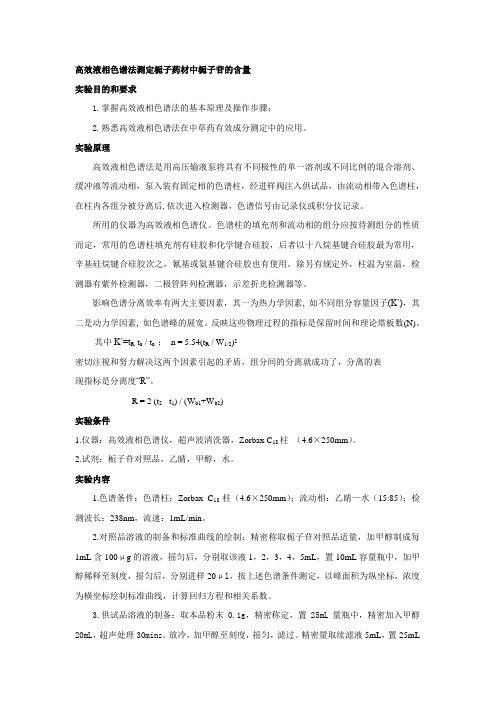
高效液相色谱法测定栀子药材中栀子苷的含量实验目的和要求1.掌握高效液相色谱法的基本原理及操作步骤;2.熟悉高效液相色谱法在中草药有效成分测定中的应用。
实验原理高效液相色谱法是用高压输液泵将具有不同极性的单一溶剂或不同比例的混合溶剂、缓冲液等流动相,泵入装有固定相的色谱柱,经进样阀注入供试品,由流动相带入色谱柱,在柱内各组分被分离后,依次进入检测器,色谱信号由记录仪或积分仪记录。
所用的仪器为高效液相色谱仪。
色谱柱的填充剂和流动相的组分应按待测组分的性质而定,常用的色谱柱填充剂有硅胶和化学键合硅胶,后者以十八烷基键合硅胶最为常用,辛基硅烷键合硅胶次之,氰基或氨基键合硅胶也有使用。
除另有规定外,柱温为室温,检测器有紫外检测器,二极管阵列检测器,示差折光检测器等。
影响色谱分离效率有两大主要因素,其一为热力学因素, 如不同组分容量因子(K’),其二是动力学因素, 如色谱峰的展宽。
反映这些物理过程的指标是保留时间和理论塔板数(N)。
其中K’=t R-t o / t o ;n = 5.54(t R / W1/2)2密切注视和努力解决这两个因素引起的矛盾,组分间的分离就成功了,分离的表现指标是分离度“R”。
R = 2 (t2 - t1) / (W b1+W b2)实验条件1.仪器:高效液相色谱仪,超声波清洗器,Zorbax C18柱(4.6×250mm)。
2.试剂:栀子苷对照品,乙睛,甲醇,水。
实验内容1.色谱条件:色谱柱:Zorbax C18柱(4.6×250mm);流动相:乙睛—水(15:85);检测波长:238nm,流速:1mL/min。
2.对照品溶液的制备和标准曲线的绘制:精密称取栀子苷对照品适量,加甲醇制成每1mL含100μg的溶液,摇匀后,分别取该液1,2,3,4,5mL,置10mL容量瓶中,加甲醇稀释至刻度,摇匀后,分别进样20μl,按上述色谱条件测定,以峰面积为纵坐标,浓度为横坐标绘制标准曲线,计算回归方程和相关系数。
高效液相色谱法测定栀子中栀子甙的含量

栀子别名黄栀子 、 黄果树 、 山栀子 、 红枝子 、 山栀 、 白蟾 , 是茜 草 称取 同一批 的栀 子样 品 6份 , 按测定方法项下 的方 法制备供试 科植物栀子 的果实 。栀子具有护肝 、 利胆 、 降压 、 镇静 、 止血 、 消肿 等 品溶液 , 测定含量 , 并计算样 品的 R S D值 , 结果 R S D为 0 . 6 3 %, 结果 作 用㈣ 。栀子的果实是传统 中药 , 属 卫生部颁 布的第 l 批药食两用 表 明此方法的重现性 良好 。 资源。 栀子常用于治疗 黄疸 型肝炎 、 扭挫伤 、 高血压 、 糖尿病等症[ 3 - 6 ] 。 2 . 7准确度试验 《 本草通玄》 记载 : “ 仲景多用枝 子茵陈 , 取其利小便而蠲湿热也 。古 取对 照品适量 , 分别 添加供试 品中 , 含 量分别相 当于标示 量 的 方治心痛 , 每用枝子 , 此为火气上逆 , 不得下降者设也 。 ( 若) 泥丹溪之 1 2 0 %、 1 5 0 %、 1 8 0 %。 取模拟样品照“ 含量测定”项 下方法试验 ,计 说, 不分寒热 , 通用枝子 , 属寒者何以堪 之。 ” 栀子含有去羟栀子甙泊 算 回收率为 9 9 . 8 %,R S D为 0 . 5 2 %。 素一 1 一葡萄糖甙 、 栀子素 、 藏红花素 、 格尼泊素 一 1 一B— D 一龙胆二糖 2 . 8 样 品稳定性试验 甙等。 现代药理研究表 明栀子具有镇静 、 降压 、 凝血 、 抑制 胃酸 、 泻下 取同一批栀子样 品, 按2 _ 3 项下 的供试 品制备方法制备供试 品 , 等作用。 本实验采用高效液相色谱法对栀子中的栀子甙 的进行 了含 将供试品置室 温下放置 , 分别 于第 0 、 1 、 2 、 3 、 4 、 5 、 6小 时 , 精密 吸取 量测定。 供试品溶液 l O 注入液相色谱仪中 , 记录色谱图。 测定栀子 中栀子 1仪 器 与 试 药 甙的 R S D = O . 6 3 %。结果表明供试 品 6 小时 内稳定 。 1 . 1 仪器 : S P E C O R D 2 5 0 P L U S紫外可见分光光度计 ( 德 国耶拿 2 . 9样 品含量测定 分析仪 器股 份公 司 ) ; F A1 0 0 4万分之一分析天平 ( 上海书培实验设 依 照上述含量测定方法 ,测定栀子三批样 品中栀 子甙的含量 , 备有 限公 司 ) ; 赛多 利斯 P B 一 1 0酸度 计( 北京晨 曦勇创科 技有 限公 结果三批样 品的含量分别为 1 . 9 %、 2 . O %、 1 . 9 %。 3讨 论 司) ; 博翔兴 旺 8 0 K H Z 高频超声波 清洗机( 北京博 宇宝威实验设 备 有 限公 司) ; 莱伯泰科 L C 6 0 0高效液相色谱仪( 北京莱伯泰科仪器股 3 . 1流 动 相 的 选 择 份有 限公 司) ; R 一 2 1 0 瑞士 B U C H I 旋转蒸发仪f J 一 州 尚准仪 器有 限公 分 别考察水 一甲醇 一磷 酸( 4 0 : 6 0 : 0 . 0 1 ) , 水 一甲醇 一乙腈 一磷 酸( 5 0 : 1 0 : 4 0 : 0 . 0 1 ) , 0 . 1 %醋酸铵溶液 一甲醇 ( 8 0 : 2 0 ) , 水 一甲醇 一乙 司); H Q 一 5 0高端试剂级超纯水机 ( 郑 州华新 电气公 司) 。 5 0 : 1 0 : 4 0 ) , 甲醇 一水 一三 乙胺 ( 7 0: 3 0 : 0 . 2 ) , 水 一乙腈 ( 8 5 : 1 5 ) 不 1 . 2 色谱柱 : 奥泰公司 c 色谱柱 ( 2 2 0 m m× 4 . 6 m m, 5 X I m) 。 腈( 1 . 3 对 照品 : 栀 子 甙 同比例 的流 动相 , 结果 以水 一乙腈 ( 8 5 : 1 5 ) 为流动相为流动 相 , 供试 1 . 4试剂 : 甲醇 ( 金坛市金冠 化工厂 ) 、 乙腈 ( 天津 市顺 呈化 工有 品各峰分离效果最好 , 故选用水 一乙腈 ( 8 5 : 1 5 ) 为流动相为流动相。 限公 司 ) 、 三 乙胺 ( 济南鸿 鑫化工有 限公 司) 、 磷 酸( 金 坛市金冠化工 3 . 2检测波长的选择 厂) 、 醋酸铵 ( 济南润 尔特化工有 限公司 ) 。 制备栀子甙对照 品稀 释液 照紫外 一可见分光光度法 ( 中国药 典 1 . 5 试药: 栀子 2 0 1 0 版 一 部 附 录 V A) , 于 1 9 0 ~9 0 0 n m 波 长 范 围 内进 行 全 波长 光 2测 定 方 法 确 定 谱扫描 , 记 录吸收光谱 。在 2 3 8 n m处有最大 吸收峰 , 故选 用 2 3 8 n m 为检测波长【 1 1 。 2 . 1色谱条件 本实验表 明此方法分离效果好 、 方法 简便 、 快捷、 准确, 、 专属性 依据查阅文献及考查 的结果 , 确定色谱 条件如下 。 流动相 : 水一 可用 于栀 子 中栀 子 甙 的 含 量 测 定 。 乙腈 ( 8 5 : 1 5 ) 为流动相 , 检测波长 : 2 3 8 n m, 流速 : 1 . 0 m l ・ mi n ~ 。柱 温 : 好, 参 考 文 献 3 0  ̄ C。理论板数按栀子甙峰计算应不得低于 2 0 0 0 。 2 . 2对 照品溶液 的制备 【 1 】 李利娟, 李宏 霞, 吴欣桐, 鄢波, 周 东. 栀 子甙对血管性痴呆 大鼠行 为 J 】 . 四川大 学学报 ( 医学版) , 2 0 0 9 ( 4 ) . 精密称 取栀子甙对照 品适 量 ,置容量 瓶中 ,加流 动相制成每 学和脑组 织病理改 变的影响『 l m L含 2 0 g的溶 液 , 即得。 【 2 】 杨奎, 闵志强, 石娅萍, 向靓 , 蒙亚江, 邬春 久, 黄薇, 唐 波. 栀予 总环 烯 醚萜苷 对脑 出血 大鼠炎症反应与神 经元凋亡的影响[ J ] . 中药新 药与 2 . 3 供试 品溶液 的制备 取供试 品粉 碎 , 精 密称取 ( 相当于栀子甙 2 0 0 g ) , 置具塞锥形 临床 药理。 2 0 0 9 ( 1 ) . 瓶中, 精密加入 流动相 1 0 mL , 密塞 , 精密称定重 量 , 超声处理 2 0分 【 3 ] 任强, 孙 丽华, 刘新 民, 刘春 雨, 权 丽辉 , 谢忱 , 廖永 红. 栀 子的化 学成 J 1 . 广 东药学院学报, 2 0 0 9 ( 2 ) . 钟, 放冷, 精密称定 , 用 流动相补 足重量 , 摇匀 , 滤过 。取续滤液 , 即 分及抗 白血病活性研 究『 得。 『 4 】 刘益华, 李 晶, 林 曼婷, 周海虹, 陈少东. 栀 子有效成分栀子苷 的现代 2 . 4精 密 度 试 验 研 究进展『 J 1 . 中国药学杂志, 2 0 1 2 ( 6 ) . 精密称取栀 子甙对照 品适量 ,加流动相使 溶解 ,制成 浓度为 【 5 】 丁 嵩涛, 刘洪涛, 李文明, 李秀英, 于超. 栀 子苷对氧化 应激损伤血 管 2 O g ・ mL - 的供试 品溶液 。照上述 色谱条件 , 精密吸取 1 O l , 连续 内皮细胞的保护作 用『 J ] . 中国药理学通报, 2 0 0 9 (  ̄. 6 】 李宝莉腾 雅 慧, 杨 暄' 古 月 锐, 方志远, 袁秉祥 . 栀子油的提取和 对中枢 进样 6次 , 记 录峰面积 。 结果, R S D = 0 . 5 5 %, 表 明本方法精密度 良好。 【 2 . 5 对 照品的线性考察 神 经系统的作用『 J ] . 第四军医大学学报, 2 0 0 8 ( 2 3 ) . 精密称取适 量栀 子甙对照 品 , 加人流动相溶液使溶解分别配制 成每毫升含 5 、 1 0 、 1 5 、 2 0 、 2 5 、 3 0 、 3 5 、 4 0 、 4 5 、 5 0微克的溶液 。分别精 密上述溶液吸取 l 0 L , 注人液相色谱仪 , 依照 2 . 1 项下 的色谱条件 测定 , 记录色谱峰 。以峰面积 ) 为纵坐标 , 对照 品进样量㈤ 为横坐 标, 绘 制标准曲线 , 计算 回归方程 。结果 表明 , 栀子 甙在 5~ 5 0 g ・ m L - 范 围内呈 良好的线性关 系。
高效液相色谱法测定栀子金花丸中栀子苷含量

高效液相色谱法测定栀子金花丸中栀子苷含量
李海洲;亓彦平
【期刊名称】《中国药业》
【年(卷),期】2005(14)9
【摘要】目的:测定栀子金花丸中栀子苷的含量以控制产品质量.方法:采用Hyper-sil ODS柱(250mm×4.6 mm,5μm,大连依利特公司)为色谱柱,以乙腈-水-三乙胺(10:90:0.1)为流动相,流速为1.0 mL/min,检测波长为240 nm,柱温为室温.结果:栀子苷的平均回收率为99.6%.结论:高效液相色谱法准确、重现性好,可用于栀子金花丸的质量控制.
【总页数】1页(P50-50)
【作者】李海洲;亓彦平
【作者单位】山东省莱芜市药品检验所,山东,莱芜,271100;山东省莱芜市中医医院,山东,莱芜,271100
【正文语种】中文
【中图分类】R286.0;R927.2
【相关文献】
1.HPLC法测定栀子金花丸中栀子苷的含量 [J], 巴力吉尼玛;包保全;朱艳红;莫日根高娃;吴双玉;月亮
2.双波长HPLC测定栀子金花丸中栀子苷、黄芩苷、盐酸小檗碱和大黄素的含量[J], 高旭东;师永清;陈士恩;郝宝成;梁剑平
3.反相高效液相色谱法测定栀子金花丸中栀子苷的含量 [J], 郭永成;王学蕾
4.RP-HPLC法测定栀子金花丸中栀子苷的含量 [J], 包淑英;傅红;张义友;王巍;刘洪利;黄振宇
5.栀子金花丸中栀子苷含量的胶束毛细管电泳法测定 [J], 王晓可;毋福海
因版权原因,仅展示原文概要,查看原文内容请购买。
栀子苷的含量测定

高效液相色谱法测定栀子药材中栀子苷的含量实验目的和要求1.掌握高效液相色谱法的基本原理及操作步骤;2.熟悉高效液相色谱法在中草药有效成分测定中的应用。
实验原理高效液相色谱法是用高压输液泵将具有不同极性的单一溶剂或不同比例的混合溶剂、缓冲液等流动相,泵入装有固定相的色谱柱,经进样阀注入供试品,由流动相带入色谱柱,在柱内各组分被分离后,依次进入检测器,色谱信号由记录仪或积分仪记录。
所用的仪器为高效液相色谱仪。
色谱柱的填充剂和流动相的组分应按待测组分的性质而定,常用的色谱柱填充剂有硅胶和化学键合硅胶,后者以十八烷基键合硅胶最为常用,辛基硅烷键合硅胶次之,氰基或氨基键合硅胶也有使用。
除另有规定外,柱温为室温,检测器有紫外检测器,二极管阵列检测器,示差折光检测器等。
影响色谱分离效率有两大主要因素,其一为热力学因素, 如不同组分容量因子(K’),其二是动力学因素, 如色谱峰的展宽。
反映这些物理过程的指标是保留时间和理论塔板数(N)。
其中K’=t R-t o / t o ;n = 5.54(t R / W1/2)2密切注视和努力解决这两个因素引起的矛盾,组分间的分离就成功了,分离的表现指标是分离度“R”。
R = 2 (t2 - t1) / (W b1+W b2)实验条件1.仪器:高效液相色谱仪,超声波清洗器,Zorbax C18柱(4.6×250mm)。
2.试剂:栀子苷对照品,乙睛,甲醇,水。
实验内容1.色谱条件:色谱柱:Zorbax C18柱(4.6×250mm);流动相:乙睛—水(15:85);检测波长:238nm,流速:1mL/min。
2.对照品溶液的制备和标准曲线的绘制:精密称取栀子苷对照品适量,加甲醇制成每1mL含100μg的溶液,摇匀后,分别取该液1,2,3,4,5mL,置10mL容量瓶中,加甲醇稀释至刻度,摇匀后,分别进样20μl,按上述色谱条件测定,以峰面积为纵坐标,浓度为横坐标绘制标准曲线,计算回归方程和相关系数。
高效液相色谱法测定利胆排导片中栀子苷含量

ai slt n (2: 8 . h o m e prtr w s4 c oui d o 1 8 )T e cl n t ea e a 0℃ , ew vlnt frdtco a 3 m,o a a 10m / i. eut u m u t ae g e t n w s2 8n fw rt w s . L mn R sl h e ho ei l e s
清 热 化 湿 、 肝 理 气 、 郁 祛 瘀 、 胆 排 石 之 功 效 , 床 用 于 肝 胆 疏 开 利 临 系 统 结 石 、 囊 炎 …。 方 中 栀 子 的 主 要 有 效 成 分 栀 子 苷 , 标 准 胆 处 原 中无 含 量 测 定 方 法 。 为更 好 地 控 制 制剂 的 内在 质 量 , 者 采 用 高 笔 效 液 相 色 谱 法 测 定 利 胆 排 导 片 中栀 子 苷 的 含 量 , 报 道 如 下 。 现 1 仪 器 与 试 药 L 2 1 A型 高 效 液 相 色 谱 仪 , L S V C一 0 0 C A S— P色 谱 工 作 站 ( 日 本 岛 津 ) 栀 子 苷 对 照 品 ( 号 为 1 04 2 0 1 , 国药 品 生 物 。 批 17 9— 0 6 3 中 制 品检 定 所 , 含 量 测 定 用 )利 胆 排 导 片 ( 院制 剂 室 , 号 分别 供 ; 医 批 为 2 0 0 1 ,0 9 7 8 2 00 2 ) 乙腈 为 色 谱 纯 , 为 娃 哈 哈 0 9 7 1 2 0 0 1 ,0 9 7 5 ; 水
o is f r t asa i g syn .K e wor : d n a d o y ds Li a p i a Ta l t; e i o i e HPL c ne t ee mi ai n b es g n p sd ; C; o tn d tr n to
RP-HPLC法测定药材栀子及其提取物中栀子苷的含量
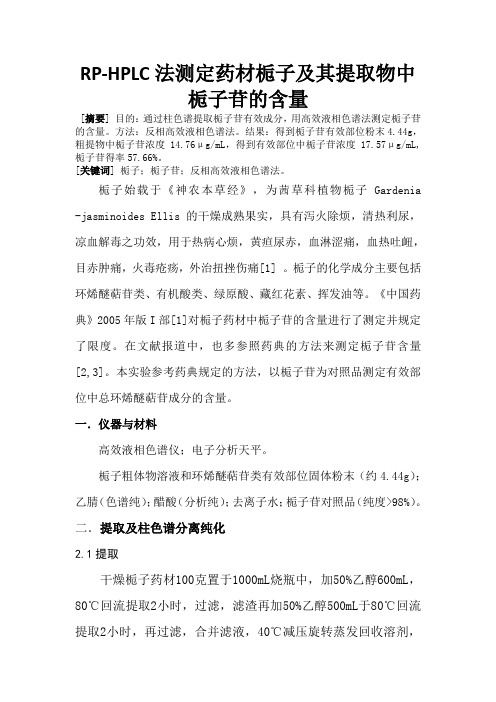
RP-HPLC法测定药材栀子及其提取物中栀子苷的含量[摘要] 目的:通过柱色谱提取栀子苷有效成分,用高效液相色谱法测定栀子苷的含量。
方法:反相高效液相色谱法。
结果:得到栀子苷有效部位粉末4.44g,粗提物中栀子苷浓度14.76μg/mL,得到有效部位中栀子苷浓度17.57μg/mL,栀子苷得率57.66%。
[关键词] 栀子;栀子苷;反相高效液相色谱法。
栀子始载于《神农本草经》,为茜草科植物栀子Gardenia -jasminoides Ellis的干燥成熟果实,具有泻火除烦,清热利尿,凉血解毒之功效,用于热病心烦,黄疸尿赤,血淋涩痛,血热吐衄,目赤肿痛,火毒疮疡,外治扭挫伤痛[1] 。
栀子的化学成分主要包括环烯醚萜苷类、有机酸类、绿原酸、藏红花素、挥发油等。
《中国药典》2005年版I部[1]对栀子药材中栀子苷的含量进行了测定并规定了限度。
在文献报道中,也多参照药典的方法来测定栀子苷含量[2,3]。
本实验参考药典规定的方法,以栀子苷为对照品测定有效部位中总环烯醚萜苷成分的含量。
一.仪器与材料高效液相色谱仪;电子分析天平。
栀子粗体物溶液和环烯醚萜苷类有效部位固体粉末(约4.44g);乙腈(色谱纯);醋酸(分析纯);去离子水;栀子苷对照品(纯度>98%)。
二.提取及柱色谱分离纯化2.1提取干燥栀子药材100克置于1000mL烧瓶中,加50%乙醇600mL,80℃回流提取2小时,过滤,滤渣再加50%乙醇500mL于80℃回流提取2小时,再过滤,合并滤液,40℃减压旋转蒸发回收溶剂,浓缩至120mL,离心出去沉淀,得到栀子苷环悕醚萜苷的提取液。
2.2 柱色谱分离纯化(1)大孔吸附树脂预处理树脂用95%乙醇浸泡4小时,然后用乙醇淋洗,至流出液在试管中用水稀释不浑浊为止,最后用水反复洗涤至无明显乙醇味后即可使用。
(2)装柱洗涤层析柱,底部塞入玻璃棉少许。
取适量大孔吸附树脂于烧杯中,加水搅动倒入层析柱,控制层析柱出口水流,(水面不能低于树脂,以免产生气泡),树脂约装满柱的2/3,顶端再用少许玻璃棉覆盖,以防止上样和洗脱时树脂被冲起。
HPLC法同时测定栀子胶囊中栀子苷和葛根素含量
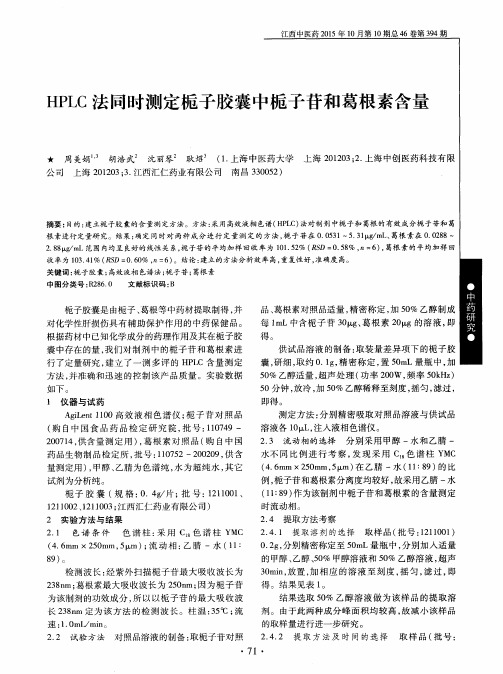
为质量控制标准中指标 , 是否能充分代表其药物的 本身价值 , 是每个起草质量标准人员需充分考虑的
问题 。
( 收稿 日期 : 2 0 1 5 - 0 2 - 0 3 ) 编辑 : 翟 兴 英
2 . 5 . 4 溶液 的稳 定 性 试 验
取 供 试 品溶 液 在 不 同
・
7 3・
表 6 栀予胶 囊重复性试验
一
一
~
表 7 栀子胶 囊栀子苷加样 回收率试验
一
~ 一
选择适宜的指标 , 才能起到稳定化 学指标进而保证
药效 作用 的 目的。 中药 成 分 复杂 , 目标 成 分 含 量极 其低 , 甚 至乎 是万分 之几 , 采 用有 效成分 定量 检测作
长2 3 8 n m定 为 该 方 法 的 检 测 波 长 。柱 温 : 3 5 ℃; 流
速: 1 . 0 m L / mi n 。
3 0 mi n , 放置 , 加相应 的溶液 至刻度 , 摇匀, 滤过 , 即
得 。结 果见 表 1 。
结果选 取 5 0 % 乙醇 溶 液 做 为该 样 品 的提 取 溶
A g i L e n t 1 1 0 0高 效 液 相 色 谱 仪 ; 栀 子 苷对 照 品 ( 购 自中 国食 品药 品检 定 研 究 院 , 批号: 1 1 0 7 4 9— 2 0 0 7 1 4 , 供含 量 测 定 用 ) , 葛根素对照 品( 购 自中 国
药 品生 物制 品检 定 所 , 批号 : 1 1 0 7 5 2—2 0 0 2 0 9 , 供 含
例, 栀子 苷 和葛根 素分 离度 均较好 , 故 采用 乙腈 一水 ( 1 1 : 8 9 ) 作 为该 制剂 中栀 子苷 和 葛根 素 的含量 测 定
高效液相色谱法测定丹栀逍遥丸中栀子苷的含量

高效液相色谱法测定丹栀逍遥丸中栀子苷的含量
周瑾
【期刊名称】《海峡药学》
【年(卷),期】2006(18)1
【摘要】目的采用高效液相色谱法测定丹栀逍遥丸中栀子苷的含量.方法色谱柱为Kromasil C18柱(150×4.6mm,5μm),流动相为:乙腈∶水(15∶85);流
速:1.0ml·min-1,检测波长为238nm.结果栀子苷的进样量在0.30~3.00μg范围内与峰面积呈良好线形(r=0.9994);平均回收率为98.96%,RSD为1.32%(n=5).结论该法简便,结果可靠,可有效地用于丹栀逍遥丸的质量控制.
【总页数】2页(P67-68)
【作者】周瑾
【作者单位】福州市药品检验所,福州,350007
【正文语种】中文
【中图分类】R927.2
【相关文献】
1.高效液相色谱法测定清开灵注射液中栀子苷含量不确定度的评定 [J], 陈佳;陈骁鹏;郭玮璐
2.高效液相色谱法测定丹栀逍遥丸中丹皮酚含量 [J], 张光仁;严亨波;董秀芳;王育
3.高效液相色谱法测定兽药龙胆泻肝散中龙胆苦苷、栀子苷和黄芩苷的含量 [J], 栾庆祥;黄鑫;杨强;金晓峰;钱莘莘
4.高效液相色谱法测定清瘟解毒口服液中栀子苷的含量研究 [J], 杨森;李攀登;李灵
娟;王彬;杨振豪
5.高效液相色谱法测定蒙成药敖必得斯-23丸中栀子苷含量 [J], 王皓;贺鹏;宝山;巴乙拉;成志平
因版权原因,仅展示原文概要,查看原文内容请购买。
高效液相色谱法测定江津栀子中栀子苷含量

高效液相色谱法测定江津栀子中栀子苷含量黄群莲;唐灿;张彦燕;李云鹏;赵剑【期刊名称】《中国药业》【年(卷),期】2011(20)11【摘要】Objective To establish the HPLC method for determining the cotent of geniposide in Fructus Gardeniae. Methods UltimateTM C18 column was adopted (250 mm × 4. 6 mm, 5 μm) ,the mobile phase was water - acetonitrile(90 ∶ 10). flowrate was 1. 0 mL/min, temperature was 25 ℃ , wavelength was 238 nm. Results The calibration curve is linear in the range of 3.2-11.2 μg, and the regression formula is Y = - 439 843.76 + 1 012 294. 70X, r = 0. 999 2( n = 5) , average recovery rate was 99. 34% , RSD = 1. 49% ( n =6) . Conclusion HPLC is suitable for the determination of geniposide in Fructus Gardeniae from Jiangjin city. This method operated convenientely,the result is stable and has good repeatability,recovery and precision. It can be widely used for the quality control of Fructus Gardeniae.%目的建立测定江津栀子中栀子苷含量的高效液相色谱法.方法色谱柱为UltimateTMC18键合硅胶柱(250mm×4.6mm,5μm),流动相为乙腈-水(10∶90),流速1.0 mL/min,温度25℃,检测波长238nm.结果栀子苷进样量在3.2~11.2μg范围内与峰面积呈良好的线性关系,回归方程为Y=-439 843.76+1 012 294.70X,r=0.999 2(n=5);平均加样回收率为99.34%,RSD=1.49%(n=6).结论高效液相色谱法测定江津栀子中栀子苷的含量,操作简便、结果稳定,精密度、重现性、回收率均较好.【总页数】3页(P20-22)【作者】黄群莲;唐灿;张彦燕;李云鹏;赵剑【作者单位】泸州医学院附属医院药剂科,四川,泸州,646000;泸州医学院药学院,四川,泸州,646000;泸州医学院药学院,四川,泸州,646000;泸州医学院药学院,四川,泸州,646000;泸州医学院药学院,四川,泸州,646000【正文语种】中文【中图分类】R284.1;R282.71【相关文献】1.高效液相色谱法测定栀芩清肺丸中栀子苷的含量 [J], 张广春;陈明明;杨敏;巩阳2.高效液相色谱法测定连栀胶囊中连翘苷和栀子苷含量 [J], 许红辉;张永锋;赵韶华;柏艳柳;李晓燕3.高效液相色谱法测定复方丹栀胶囊中栀子苷含量 [J], 许风顺;俞新君;陈进;聂丽云4.高效液相色谱法测定栀姜口服液中栀子苷的含量 [J], 谢鹏;赵洪梅5.高效液相色谱法测定栀姜口服液中栀子苷的含量 [J], 谢鹏;赵洪梅;因版权原因,仅展示原文概要,查看原文内容请购买。
高效液相色谱法测定失眠颗粒中栀子苷含量

美国 A g i l e n t L C 一 1 2 6 0型液 相 色 谱 仪 ( 四元 泵 G1 3 1 1 B; 自动 进样器 G 1 3 2 9 B;柱 温 箱 G 1 3 1 6 A;二 极 管 阵 列 检测 器 G 4 2 1 2 B; L A B o p e n色 谱数 据 工作 站 ) 。B P 2 1 1 D型 电子 分 析天 平 ( 德 国 赛 多利 斯 天 平 有 限 公 司 ) 。栀 子苷 对 照 品 ( 供 含 量 测 定用 , 批 号 为 7 4 9 — 9 2 0 2 , 中 国药 品生 物 制品 检定 所 ) ; 乙腈 为 色谱 纯 , 水 为 娃 哈 哈纯 净 水 , 其他 试 剂均 为 分 析纯 ; 失 眠颗 粒 ( 陕 西省 中医 医 院 , 批
溶 液在 2 4 h内 稳 定 。
加样 回收试 验 : 取 已知含 量样 品 约 0 . 2 5 g , 共 6份 , 精密称定 , 分 别加 入 1 m L栀子 苷对 照 品溶 液 ( 质量 浓度 为 0 . 4 2 5 a r g / m E ) , 照 供 试 品溶液 制备方 法 , 依 法测 定含 量 , 计 算 回收率 。结 果见 表 1 。
失 眠颗 粒 原 以汤 剂应 用于 临 床 , 由栀 子 、 丹皮 、 黄芩 、 柴胡、 郁金等 l 7味 中药 提取 精 制 而 成 , 源 于 临 床经 验 方 , 具 有疏 肝清 热、 养 血 安 神 的功 效 , 用 于肝 郁化 热 、 心 神 失养 型失 眠症 。 方 中君 药 为 牡 丹皮 、 栀子 , 丹 皮 酚在 方 中含 量较 低 , 易 挥发 , 不便 用 于 定 量; 栀 子 中主要 含 栀 子苷 , 具 有抗 炎 利胆 、 抗肿瘤、 降血 糖 等 多种 药 理 作 用【 1 1 , 且含 量 较 高 , 因此 选择 栀子 苷 的含 量 作 为考 察指 标 。 为有 效 控制 产 品 质量 , 保 证 用药 安全 , 笔 者 建立 了失 眠 颗粒 中栀 子苷 含 量测 定 方 法 ,以期 为 更好 的控 制 失 眠颗 粒 的产 品质 量 提 供 科 学 依据 。
应用高效液相色谱法测定丹栀逍遥合剂的栀子甙含量实验研究

应用高效液相色谱法测定丹栀逍遥合剂的栀子甙含量实验研究张作军【期刊名称】《中国处方药》【年(卷),期】2017(015)002【摘要】目的:进一步探究高效液相色谱法在测定丹栀逍遥合剂中栀子苷含量的应用价值。
方法采用高效液相色谱法对临床上常用的丹栀逍遥合剂成分进行测定。
取DAD检测器,对栀子苷检测波长设为237 nm进行检测。
其流动相以及Hypersil ODS参数分别设为:流动相:甲醇-0.3%的磷酸溶液;洗脱梯度:0~30 min,甲醇25%~95%,0.3%磷酸溶液75%~5%;Hypersil ODS参数:5μm,250 mm×4.6 mm;此外,柱温、流速分别为40℃、1.0 mL/min。
结果丹栀逍遥合剂中栀子苷线性范围为0.20~0.70μg(r=0.9998),其平均含量为4.26 mg/g,其平均回收率达101.4%。
结论对于丹栀逍遥合剂中栀子苷含量的检测采用高效液相色谱法不仅耗时短、准确率高,而且便捷易行,易控制制剂质量,应予推广。
【总页数】2页(P28-29)【作者】张作军【作者单位】南京中医药大学连云港附属医院,江苏连云港 225004【正文语种】中文【相关文献】1.HPLC法测定丹栀逍遥片中栀子苷的含量 [J], 庄伟霞;陈东鸿;黄晓姗;邹义栩2.HPLC法测定丹栀逍遥片中芍药苷的含量 [J], 谭亚亚;王莉;吕卓3.反相高效液相色谱法测定丹栀逍遥片中丹皮酚的含量 [J], 雷玉萍;李瑞莲4.石墨炉原子吸收分光光度法测定丹栀逍遥片中铅的含量 [J], 韩立路5.RP-HPLC法测定丹栀丸中栀子甙含量 [J], 李耀林;梁军;王立新;贾继明;张景艳因版权原因,仅展示原文概要,查看原文内容请购买。
- 1、下载文档前请自行甄别文档内容的完整性,平台不提供额外的编辑、内容补充、找答案等附加服务。
- 2、"仅部分预览"的文档,不可在线预览部分如存在完整性等问题,可反馈申请退款(可完整预览的文档不适用该条件!)。
- 3、如文档侵犯您的权益,请联系客服反馈,我们会尽快为您处理(人工客服工作时间:9:00-18:30)。
实验2 高效液相色谱法测定栀子药材中栀子苷的含量学时分配:6学时实验目的和要求1.掌握高效液相色谱法的基本原理及操作步骤;2.熟悉高效液相色谱法在中草药有效成分测定中的应用。
实验原理高效液相色谱法是用高压输液泵将具有不同极性的单一溶剂或不同比例的混合溶剂、缓冲液等流动相,泵入装有固定相的色谱柱,经进样阀注入供试品,由流动相带入色谱柱,在柱内各组分被分离后,依次进入检测器,色谱信号由记录仪或积分仪记录。
所用的仪器为高效液相色谱仪。
色谱柱的填充剂和流动相的组分应按待测组分的性质而定,常用的色谱柱填充剂有硅胶和化学键合硅胶,后者以十八烷基键合硅胶最为常用,辛基硅烷键合硅胶次之,氰基或氨基键合硅胶也有使用。
除另有规定外,柱温为室温,检测器有紫外检测器,二极管阵列检测器,示差折光检测器等。
影响色谱分离效率有两大主要因素,其一为热力学因素, 如不同组分容量因子(K’),其二是动力学因素, 如色谱峰的展宽。
反映这些物理过程的指标是保留时间和理论塔板数(N)。
其中K’=t R-t o / t o ;n = 5.54(t R / W1/2)2密切注视和努力解决这两个因素引起的矛盾,组分间的分离就成功了,分离的表现指标是分离度“R”。
R = 2 (t2 - t1) / (W b1+W b2)实验条件1.仪器:高效液相色谱仪,超声波清洗器,Zorbax C18柱(4.6×250mm)。
2.试剂:栀子苷对照品,乙睛,甲醇,水。
实验内容1.色谱条件:色谱柱:Zorbax C18柱(4.6×250mm);流动相:乙睛—水(15:85);检测波长:238nm,流速:1mL/min。
2.对照品溶液的制备和标准曲线的绘制:精密称取栀子苷对照品适量,加甲醇制成每1mL含100μg的溶液,摇匀后,分别取该液1,2,3,4,5mL,置10mL容量瓶中,加甲醇稀释至刻度,摇匀后,分别进样20μl,按上述色谱条件测定,以峰面积为纵坐标,浓度为横坐标绘制标准曲线,计算回归方程和相关系数。
3.供试品溶液的制备:取本品粉末0.1g,精密称定,置25mL量瓶中,精密加入甲醇20mL,超声处理30min s。
放冷,加甲醇至刻度,摇匀,滤过。
精密量取续滤液10mL,置25mL容量瓶中,加甲醇至刻度,摇匀,过微孔滤膜,取续滤液,作为供试品溶液。
4.测定法:吸取供试品溶液20μl注入液相色谱仪,测定。
由标准曲线法或一点法计算样品中栀子苷的含量(C17H24O10)。
五实验记录1.扼要说明操作步骤及实验结果;2.绘制标准曲线图,及回归方程,相关系数;六思考题1.在仪器操作过程中,应重点注意哪些方面?2.用HPLC法测定中药中有效成分含量的主要优势是什么?Experiment 3 Determination of Gardenoside in Fructus Gardeniae by HPLCClass hour: 3Objectives1. Master the principles and operational method of HPLC through this experiment.2. Be familiar with the use of HPLC in determination of components in traditional Chinese medicine.PrinciplesIn high performance liquid chromatography, the mobile phase, a solvent or a solvent mixture of suitable polarity (or a buffer solution of suitable ion strength), is pumped into a column containing the stationary phase. While the sample is injected into an injector and carried into the column by the mobile phase, the components are separated on the stationary phase and each component passes through the detector in succession and thus a chromatogram is record.The stationary phase and the component part of the mobile phase should be in accordance with the qualities of test samples. Silica gel and chemically bonded silica gel are commonly used as the bulking agent. For chemically bonded silica gel, octadecylsilane type is most frequently used, followed by the octylsilane type, and the cyano and amino group bonded silica gel are occasionally used. The column is maintained at room temperature. The type of detector includes UV, DAD, SPD and so on.There are two important factors responsible for chromatographic separation efficiency. One is the thermodynamic factor, such as the capacity factor of different components (k’), the other is the dynamic factor, such as the width of peak. The indexes to reflect these physical processes are retention time (t R) and the number of theoretical plates of column (n). Calculate the value of k’ and n as follows:k’ = (t R-t o) / t o; n = 5.54 (t R / w1/2)2The separation of different components will be successful if close attention is paid and great effort is taken to solve the contradiction caused by the above factors. Theterm “resolution factor” is often used as a n index to express separation efficiency. Calculate the value of R as follows:R=2 ( t2-t1 ) / ( w b1+w b2 )Conditions1.Apparatus HPLC instrument coupled with an ultraviolet detector, Column:Zorbax C18(4.6×250mm, ultrasonic cleaner.2.Reagents Fructus gardeniae, gardenoside CRS, acetonitrile, methanol, water.Assay1. Chromatographic systemUse octadecylsilane bonded silica gel as the stationary phase and acetonitrile –water (15:85) as the mobile phase; flow rate: 1.0 mL/min; the wavelength of the detector is 238 nm and the column temperature is set in room temperature.2. Preparation of the stock solution and the standard curveThe stock solution is prepared by dissolving a quantity of gardenoside CRS in methanol to produce a solution containing 100 µg per mL. Then transfer the stock solution 1, 2, 3, 4 and 5mL to five 10mL volumetric flasks, and dilute with methanol to the volume respectively. 20µL of each of solution is analyzed using the chromatographic system showed above. The standard curve is obtained by plotting concentration versus peak area and corresponding coefficient are also calculated.3. Preparation of test solution0.1g of the sample is weighed and contained in a 25 mL volumetric flask. Add accurately 20 mL of methanol to the flask, extract for 20 mins in an ultrasonic cleaner. After that, take it out and allow it to cool. Add methanol to the mark of the volumetric flask. Shake it well and filter. After filtration, transfer accurately 10 mL of the successive filtrate to another 25 mL volumetric flask and dilute to the volume with methanol. Then the solution are mixed well and filtered with millipore membrane (particle size 0.45 µm). Thus, the successive filtrate is used as the test solution.4. Procedure20 μL of test solution is injected accurately into the column, and the content of thesample is determined according to the standard curve or one point method. Experiment records1. Describe briefly the process of this experiment.2. Plot the standard curve and calculate the regression equation and the relative factor. Questions1. What should be paid attention to in the operating of the instrument?2. What are the main advantages of HPLC in the determination of the components in Chinese medicines?。
